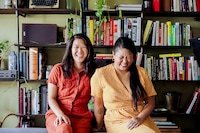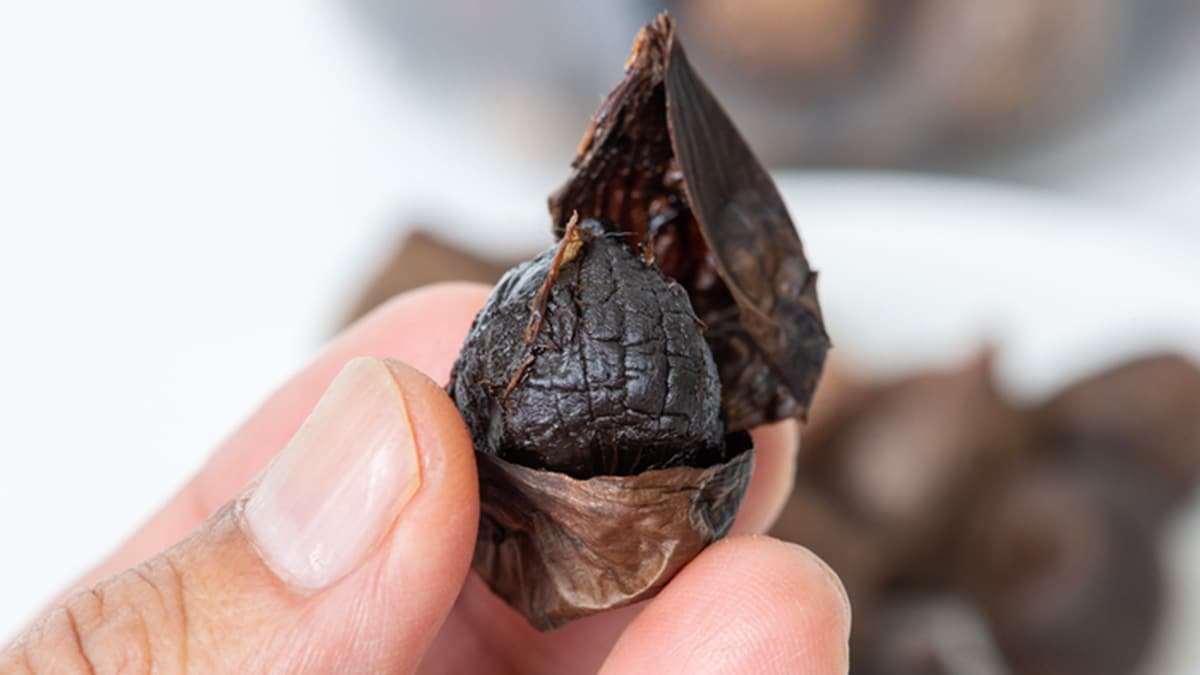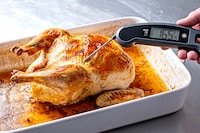Touch upon this story Remark Present Article Share
The evening earlier than heading out of city, Irene Shiang Li stares down the bag of unused arugula in her near-empty fridge in Boston. She’s checking out dinner along with her husband. “We have to eat an unlimited salad, or we are able to make a pasta and wilt the arugula into it,” she figures. She chooses pasta, tossing cooked noodles in a pan with the greens and a remnant onion half. A tin of “fancy Spanish tuna” goes in, together with some bitter cream “to present it a creamy texture.” Lastly, she squeezes a saved lemon half over it.
In the meantime, in Glasgow, Scotland, her sister Margaret “Mei” Li wants to make use of up some spinach. Her son hates the stuff. But when she places it right into a smoothie? Down the hatch, no drawback.
For the Li sisters, determining what to do with what they’ve — and what the remainder of us would possibly in any other case toss — is a matter after all. It wasn’t all the time, however educating themselves easy methods to run a restaurant with none skilled culinary or operational coaching formed them into the resourceful, adaptable, environment friendly cooks they’re as we speak, and it’s why they’re simply the folks to put in writing “Completely Good Meals,” a cookbook about waste avoidance at residence.
Commercial
“Companies are accountable for local weather change and never me,” Irene asserts. “However within the case of meals waste, it truly is customers.” In response to the Environmental Safety Company, nearly 40 % of the meals produced on this nation will get chucked within the trash, and it accounts for practically a 3rd of the meals wasted worldwide.
Surprisingly, though there are culprits alongside each hyperlink within the meals chain, “households are the most important supply of meals waste in most higher-income nations, with properties accountable for about 37 % of the uneaten meals in the US,” they write within the first few pages. Irene’s concept is, “We’re not good at waste discount as a result of it’s not our job the way in which it’s your job in the event you run a grocery retailer.” However, she says, “it is a place the place it’s honest to place the onus on the patron.”
The query is easy methods to make customers see the onus not as a burden, however as an excuse to rethink their buying and cooking in ways in which enhance their high quality of life — or consuming, on the very least. Their reply: a paperback discipline information that prioritizes performance and enjoyable, whereas offering folks with instruments they’ll apply as they’re in a position.
Commercial
“Meals has to work for folks,” Irene says. “And whether or not that’s cultural relevance, whether or not it’s value, whether or not it’s time to arrange, if it doesn’t work, it doesn’t clear up any issues. It truly can create extra issues.”
Accordingly, the e-book incorporates the very best practices the sisters have gleaned from their expertise as self-taught cooks, cookbook authors and homeowners of a meals enterprise. They’ve most likely discovered essentially the most on the job at Mei Mei, a dumpling firm Irene runs with two new companions she introduced on after shopping for out her large sister and their older brother Andy. (In Chinese language, “mei” means little sister, which explains each Margaret’s nickname and that of the enterprise.) What started as a meals truck in 2012 expanded to a bricks-and-mortar outpost a yr later, and as of January, it has morphed right into a dumpling manufacturing unit, with classroom-cum-cafe.
After leaving the household enterprise, Mei relocated to Atlanta in 2018 and launched Meals Waste Feast, a web based useful resource that reveals folks how they’ll save meals, cash and the planet, concurrently. Just a few months later, she uprooted to North Carolina. There, Mei (who now lives in Scotland) took a tour of close by landfills and noticed the size of our waste firsthand. These experiences knowledgeable the sisters’ newest challenge.
Commercial
The topic first introduced itself as a major risk in the course of the sisters’ early days within the truck, the place they noticed what losing produce can value. They needed to discover methods to supply imperfect or much less sought-after produce and burn up each a part of it. When working with close by farms, “We’d take all of the kale that had holes in it or wasn’t getting purchased on the farmer’s market, and all the barely yellowed arugula,” Mei explains. “Then we made it into this local-greens pesto, and that turned essentially the most well-known sandwich that we had at Mei Mei, the Double Superior.”
In addition they discovered the FIFO rule of chilly storage: First In, First Out. That is as logical because it sounds. You place your most perishable components up entrance, so you employ them first. The at-home model is their “Eat Me First Field.” Labeling issues lets you recognize precisely what they’re and if you stashed them.
They’ve acquired such hacks from being residence cooks like the remainder of us. The deservingly named Unintentional Finest Banana Bread “happened as a result of my sister was studying the recipe on the facet of some carton of one thing for banana bread, and he or she was most likely multitasking, and he or she will not be a exact prepare dinner or baker, and he or she overlooked an entire cup of flour,” Irene relays. As per Mei’s headnote, “out got here the moistest, softest, banana-iest bread, holding collectively simply sufficient to be sliceable, so wealthy and rewarding, however one way or the other truly feeling more healthy with a cup of white flour gone and solely the cup of whole-wheat flour nonetheless remaining.”
A guardian accountable for feeding two choosy eaters, she decided that utilizing a sheet pan to bake a frittata (one of many traditional throw-everything-in-the-pan dishes) offers you extra floor space than a skillet and means that you can customise completely different sections with completely different toppings, so each eater is a contented camper, and much more components are accounted for.
Commercial
The sisters additionally gained precious perception from writing their earlier cookbook, “Double Superior Chinese language Meals,” primarily, that they dislike normal recipe codecs. These specify singular components and portion yields that don’t go away room for flexibility, probably the most necessary tenets of waste-free cooking.
Generally you solely have sufficient of an ingredient for a single portion of a dish, or sufficient to feed a military. And typically, you don’t have the “major” ingredient in any respect, or a cited spice or condiment or herb. “Simply use no matter greens are in your fridge,” Mei says, “since you might most likely use Brussels sprouts or kale or no matter. It’s going to be completely good. And that makes your life simpler, and that makes my life as a recipe author simpler, as a result of I’ve a very onerous time writing about issues that I don’t need to ship folks to the shop for.”
The duo additionally has an issue with cookbooks’ emphasis on meals images, and that’s primarily why you received’t discover it in “Completely Good Meals.” As Mei explains, “It doesn’t make sense to have photographs the place the components are versatile, and it might look completely completely different each time.”
As a substitute, they’ve illustrations by Iris Gottlieb, who infuses humor into instructive drawings for recipes that may accommodate all method of components and substitutions, like Freewheeling Sangria, Select Your Personal Journey Paella or the good All Day We Dream of Salad. These pleasant pictures permit for infinite ingredient mixtures and contribute to the playful, chatty tone of the cookbook. “If it’s not enjoyable, it’s onerous to maintain doing it,” Irene says.
The vary and suppleness of recipes ought to provide one thing for each sort of eater, whereas staving off boredom. Received cauliflower? You don’t should roast it, complete or in components. You’ll be able to braise some in a curry with hen thighs and switch the remaining into the rice you serve with it. One ingredient, two textures; it’s intelligent and resourceful.
Commercial
The worldwide selection additionally serves as a reminder that our ancestors, if not our grandparents, practiced waste-free cooking with out pondering twice about it. “Each culinary custom — as a result of all around the world folks have had to determine easy methods to do extra with much less — has use-it-up recipes,” Irene says.
Tamar Adler has been speaking and writing about this matter for a decade. Her new launch, “The Eternal Meal Cookbook,” is a by-product of an earlier assortment of essays that explored the forgotten expertise she and the Li sisters try to rebuild into our up to date culinary routine. “I believe we now have a variety of the identical recipes, and it’s completely different paths to the identical place,” Adler says. The place Irene and Mei deploy whimsy and infographics, Adler opts for oil work and a literary model. Her hardcover is supposed to be a reference quantity that may be handed down from one era to the subsequent.
Commercial
These authors acknowledge the restrictions and potential of their readership. “For essentially the most half, in the event you take a look at the demographics of our audiences at these e-book occasions, they’ll afford to throw cash within the trash,” Irene says. “Perhaps not daily, however these will not be people who find themselves meals insecure. However they need to be ok with how they work with meals, they usually need to be extra artistic.”
She and her sister say they consider zero-waste as its personal type of aspiration. Like Adler, they perceive customers aren’t going to vary their habits — or clear up local weather change and finish meals waste — in a single day. However with their e-book, they’ve gotten a foot within the door — of our fridges — and empowered us to take some confidence-building first steps.
“It simply has fully modified the way in which I take a look at my fridge and the way in which I retailer meals and what I throw away and what I hold, and the way I store,” testifies Barbara Moran, a correspondent on local weather and the setting for Boston’s NPR information station, WBUR.
Tonight, she received’t get any bother from that unused complete head of CSA cabbage that after would have taunted her. Because of the Li sisters, she is aware of she will make okonomiyaki, a Japanese frittata-like pancake her household can’t get sufficient of.
Present this text Present Article


